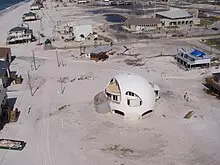
Imagine living in a home that can withstand the strongest storms, providing you with peace of mind and security. Tornadoes, cyclones, and other powerful windstorms may damage or destroy many buildings, but with the right design and construction, we can greatly reduce the impact. In this article, we will explore various methods and considerations for building a hurricane-proof home that can withstand even the most challenging weather conditions.
Building on Solid Ground: Storm Surge Considerations
Coastal areas face the destructive power of waves, which can wreak havoc on buildings. For optimal protection, it is advisable to build on high ground to avoid waves. If building near the coast is unavoidable, elevating the structure on steel, concrete, or wooden pilings, or anchoring it to solid rock, can help mitigate the risk of wave-induced damage.
Battling the Wind: Wind Loading Considerations
When strong winds hit a building, the negative pressures on the roof surfaces can create a lifting force capable of tearing off the roof. To minimize this vulnerability, it is crucial to anchor the upper structure to the foundation through the walls. "Toenailing" roof trusses into the walls may provide some resistance, but for higher force resistance, hurricane ties that nail into the wall and wrap over the trusses should be used.
Mobile homes, with their pan roof systems, are particularly susceptible to the pressure differential caused by high-velocity winds passing over the roof surface. However, this risk can be mitigated by permanently fastening aluminum tabular channels across the top of the interlocking ribs of the metal roof system. This allows the roof to withstand the forces exerted by the wind without compromising the flow of rainwater.
Harnessing Nature's Protection: Earth-Sheltering and Unique Designs
Earth-sheltered construction provides enhanced resistance to strong winds and tornadoes compared to standard construction methods. Cellars and other earth-sheltered components within a building can serve as a safe refuge during turbulent weather.
The physical geometry of a building plays a crucial role in its ability to withstand storms. Geodesic dome roofs or buildings, with their low drag coefficients, can endure higher wind forces when compared to square buildings of the same area. Monolithic dome construction takes this resilience a step further, resulting in even stronger buildings.
Round or multiple-sided homes are also more resistant to hurricane-strength winds. The design of the structure allows the wind to flow around it, reducing the pressure build-up on one side. Additionally, radial truss arrays for the roof and floors can disperse potential energy from sustained winds across the entire structure, preventing it from accumulating in one area.
Reinforcing Vulnerable Points: Building Components
Building openings, such as garage doors and windows, are often weak points susceptible to failure under wind pressure and blowing debris. Hurricane shutters provide effective protection in such cases.
Doors can be blown into the house by strong winds, potentially leading to structural failure. Windows, on the other hand, can be constructed with shatterproof glass, plastic panes, or glass with protective membranes. The use of screws or bolts to firmly attach the panes and concrete anchor screws to secure windows to the surrounding structure can enhance their resistance.
While wood offers flexibility under certain building stresses, reinforced concrete is a dense and robust material capable of withstanding the destructive power of high winds and flying debris if used in a properly designed building.
Meeting the Standards: Regulations for Safer Homes
In the aftermath of Hurricane Andrew in 1992, which caused significant damage, Florida implemented stricter building standards and enforcement. These measures included increased performance criteria for wind-load provisions and the adoption of new wind provisions from the American Society of Civil Engineers. Florida also mandated the use of missile-impact resisting glass in high-velocity hurricane zones to withstand wind-borne debris. Similarly, Hong Kong requires structures to withstand typhoon winds, ensuring the safety of its residents.
Building a Resilient Future
Creating a hurricane-proof home is not just about protecting your investment; it's about safeguarding the lives and well-being of your loved ones. By incorporating innovative design elements and following stringent building codes, you can build a sanctuary that stands strong against the harshest storms. Remember, investing in hurricane-proof construction is an investment in your future and peace of mind.


















